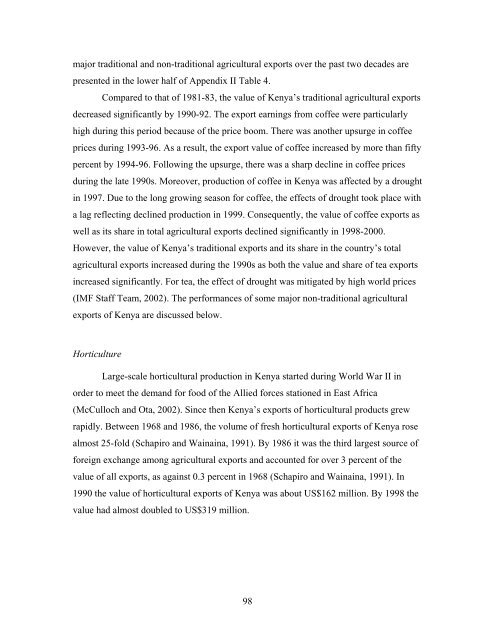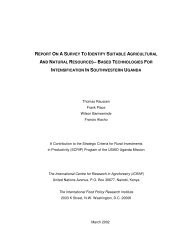Market Opportunities for African Agriculture - International Food ...
Market Opportunities for African Agriculture - International Food ...
Market Opportunities for African Agriculture - International Food ...
You also want an ePaper? Increase the reach of your titles
YUMPU automatically turns print PDFs into web optimized ePapers that Google loves.
major traditional and non-traditional agricultural exports over the past two decades are<br />
presented in the lower half of Appendix II Table 4.<br />
Compared to that of 1981-83, the value of Kenya’s traditional agricultural exports<br />
decreased significantly by 1990-92. The export earnings from coffee were particularly<br />
high during this period because of the price boom. There was another upsurge in coffee<br />
prices during 1993-96. As a result, the export value of coffee increased by more than fifty<br />
percent by 1994-96. Following the upsurge, there was a sharp decline in coffee prices<br />
during the late 1990s. Moreover, production of coffee in Kenya was affected by a drought<br />
in 1997. Due to the long growing season <strong>for</strong> coffee, the effects of drought took place with<br />
a lag reflecting declined production in 1999. Consequently, the value of coffee exports as<br />
well as its share in total agricultural exports declined significantly in 1998-2000.<br />
However, the value of Kenya’s traditional exports and its share in the country’s total<br />
agricultural exports increased during the 1990s as both the value and share of tea exports<br />
increased significantly. For tea, the effect of drought was mitigated by high world prices<br />
(IMF Staff Team, 2002). The per<strong>for</strong>mances of some major non-traditional agricultural<br />
exports of Kenya are discussed below.<br />
Horticulture<br />
Large-scale horticultural production in Kenya started during World War II in<br />
order to meet the demand <strong>for</strong> food of the Allied <strong>for</strong>ces stationed in East Africa<br />
(McCulloch and Ota, 2002). Since then Kenya’s exports of horticultural products grew<br />
rapidly. Between 1968 and 1986, the volume of fresh horticultural exports of Kenya rose<br />
almost 25-fold (Schapiro and Wainaina, 1991). By 1986 it was the third largest source of<br />
<strong>for</strong>eign exchange among agricultural exports and accounted <strong>for</strong> over 3 percent of the<br />
value of all exports, as against 0.3 percent in 1968 (Schapiro and Wainaina, 1991). In<br />
1990 the value of horticultural exports of Kenya was about US$162 million. By 1998 the<br />
value had almost doubled to US$319 million.<br />
98
















